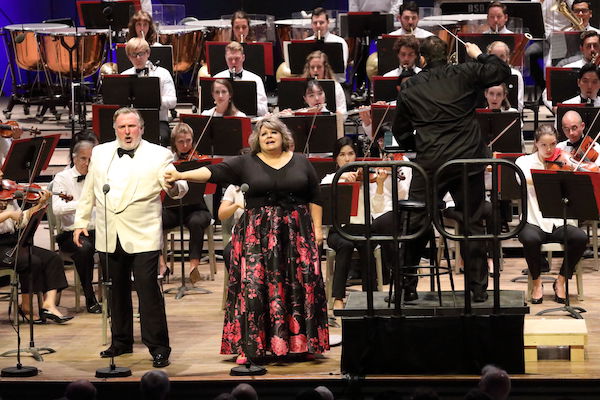Nelsons, singers present a richly dramatic Act I of Wagner’s “Die Walküre”

Concert opera has long been a Tanglewood tradition. But in the Andris Nelsons era, the works of Richard Wagner are becoming a festival fixture.
In 2017, the Latvian conductor led the Boston Symphony Orchestra in Tanglewood’s first Das Rheingold, which spotlighted a fine cast of veteran singers. His exploration of the Ring Cycle continued Saturday night at the Koussevitzky Shed, where he offered Act I of Die Walküre with the Tanglewood Music Center Orchestra. Headlining the performance was another starry lineup of seasoned Wagnerians, all of whom have risen to fame for their performances of their roles in such high-profile venues as the Metropolitan Opera, English National Opera, and the Bayreuth Festival.
Parts of Die Walküre have graced Tanglewood programming over the past decade and a half. Saturday’s performance, however, introduced a complete version of the epic drama that is being spread across three concerts this weekend.
Though the opera ultimately explores the relationships between gods and one’s will to posses a magical ring, the overall story of Die Walküre is one of all-too-human desire and lust for power. Wotan seeks to regain the ring that he lost to the giant Fafner. Unable to act directly on his own will, he sires the Wälsung twins—Siegmund and Sieglinde—whom he hopes will carry out his long-term plan of gaining ultimate rule over the world.
Act 1, in particular, tells of Siegmund casting off the pains of his past and discovering his destiny as a Wälsung who will free his sister from her loveless marriage to the brutish warrior, Hunding.
In tenor Simon O’Neill’s portrayal of Siegmund Saturday night, the character made a convincing arc from wounded runaway to bold hero. As he first stumbled into Sieglinde’s home and told her of his sorrowful past, O’Neill’s warm, delicate tenor made the character a gloomy yet amiable presence. Yet his lines glowed tenderly when the character reflected on the memories of his father. By the end of the act, O’Neill found a true heldentenor quality, with gleaming high notes conveying Siegmund’s newfound assurance as he claims the sword “Nothung” and Sieglinde for himself.
Portrayed by bass Franz-Josef Selig, Hunding was a menacing presence. Realizing that Siegmund is an enemy, Selig’s Hunding grew stern and resentful, his deep, cavernous voice expressing the obsession of a man drawn into defending the honor of his kinsmen.
Soprano Amber Wagner conveyed the full force of Sieglinde’s elation as Siegmund agrees to free her from Hunding’s yoke. Wagner possesses a rich, lustrous voice that proved capable of soaring effortlessly in the most impactful moments. As she encouraged Siegmund to claim the sword, Wagner’s singing swelled with intensity. In contrast, she explored the hushed intimacy of her love duet with O’Neill in scene three, where both singers delivered their lines with soft, almost Schubertian grace.
Act 1 of Die Walküre is a satisfying symphonic journey as well, and Andris Nelsons’s Technicolor approach revealed the score’s many details, allusions, and foreshadowing of things to come. The conductor wove an urgent accompaniment from the onset, and the strings of the Tanglewood Music Center Orchestra set the scene of Siegmund’s opening escape with robust tone and propulsive energy. The low brass sounded out Hunding’s theme with authority, and the sword theme’s upward unfolding arpeggio glittered in the winds and high brass.
Many stretches of the score bear a chamber-like delicacy, and the musicians played those passages with polish and sensitivity. The solo cello melody, played when Sieglinde gives Siegmund water, unfolded in a long silvery line.
Nelsons kept an eye toward the big picture as the act reached its dramatic height. The buildup to Siegmund’s claiming of the sword slowly released the pent-up tension, the musicians swelling their phrases in a long crescendo before reaching a stinging climactic chord.
Staging was minimal, though a final kiss between O’Neill and Wagner put a fine touch on the rousing final measures. When performed this resplendently, stage action seems almost redundant. Ultimately, Wagner’s drama is the theater of the imagination.
Die Walküre continues 2:30 p.m. and 6:30 p.m. Sunday at the Koussevitzky Shed. bso.org; 888-266-1200
Posted in Performances